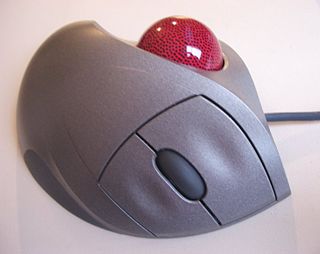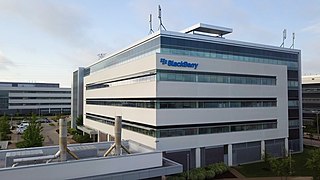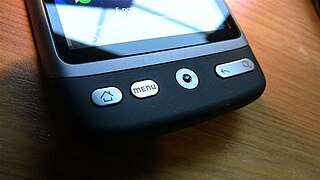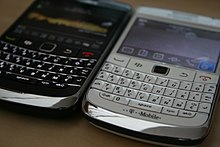
A trackball is a pointing device consisting of a ball held by a socket containing sensors to detect a rotation of the ball about two axes—like an upside-down ball mouse with an exposed protruding ball. Users roll the ball to position the on-screen pointer, using their thumb, fingers, or the palm of the hand, while using the fingertips to press the buttons.

BlackBerry was a brand of smartphones and other related mobile services and devices. The line was originally developed and maintained by the Canadian company BlackBerry Limited from 1999 to 2016, after which it was licensed to various companies.

The Danger Hiptop, also re-branded as the T-Mobile Sidekick, Mobiflip and Sharp Jump is a GPRS/EDGE/UMTS smartphone that was produced by Danger, Inc. from 2002 to 2010.

BlackBerry Limited is a Canadian software company specializing in cybersecurity. Founded in 1984, it originally developed the BlackBerry brand of interactive pagers, smartphones and tablets. In 2016, it transitioned to a cybersecurity enterprise software and services company under CEO John S. Chen. Its products are used by various businesses, car manufacturers, and government agencies to prevent hacking and ransomware attacks. They include the BlackBerry Cylance, the QNX real-time operating system; BlackBerry Enterprise Server, and a Unified Endpoint Management (UEM) platform.

The Nokia Eseries consists of business-oriented smartphones running Symbian OS, with emphasis on enhanced connectivity and support for corporate e-mail push services, as well as enterprise-styled products and many featuring QWERTY keyboards. All devices have advanced office features through its S60 platform. Phones equipped with Wireless LAN also provide a VoIP client. Throughout the series' lifetime its main competitors were BlackBerry products from Research In Motion. The Eseries was marketed until 2011.

The BlackBerry Pearl was a series of smartphones developed by Research In Motion, and was the first BlackBerry device with a camera and media player. It was originally released on September 12, 2006. T-Mobile was the first US carrier to release the phone as a carrier device. The last BlackBerry Pearl released was the 9100 series on May 13, 2010. After this model was cleared out, RIM discontinued the Pearl series.
BlackBerry OS is a discontinued proprietary mobile operating system developed by Canadian company BlackBerry Limited for its BlackBerry line of smartphone handheld devices. The operating system provides multitasking and supports specialized input devices adopted by BlackBerry for use in its handhelds, particularly the trackwheel, trackball, and most recently, the trackpad and touchscreen.
The BlackBerry Bold is a line of smartphones developed by BlackBerry Limited. The family was launched in 2008 with the 9000 Model. In 2009 the form factor was shrunk with the 9700 and the Tour 9630. In 2010 BlackBerry released the 9650 and 9780 refreshed with OS 6. In 2011 came the 9790 and 9788 along with the 9900/9930 series. The 9900/9930 and 9790 are touchscreen smartphones, released in August and November 2011.

The BlackBerry Storm is a touchscreen smartphone developed by Research In Motion. A part of the BlackBerry 9500 series of phones, it was RIM's first touchscreen device, and its first without a physical keyboard. It featured a touchscreen that responded like a button via SurePress, Research In Motion's haptic feedback technology. Its competitors included Apple's iPhone, the Palm Pre, the T-Mobile G1 by HTC and the HTC Touch family.

The HTC Dream is a smartphone developed by HTC. First released in September 2008, the Dream was the first commercially released device to use the Linux-based Android operating system, which was purchased and further developed by Google and the Open Handset Alliance to create an open competitor to other major smartphone platforms of the time, such as Symbian, BlackBerry OS, and iPhone OS. The operating system offers a customizable graphical user interface, integration with Google services such as Gmail, a notification system that shows a list of recent messages pushed from apps, and Android Market for downloading additional apps.
BlackBerry Curve is a brand of professional smartphones that were manufactured by BlackBerry Ltd from 2007 until 2013.
BlackBerry World was an application distribution service by BlackBerry Limited. The service provided BlackBerry users with an environment to browse, download, and update mobile apps, including third-party applications.

Samsung Galaxy is a series of computing and mobile computing devices that are designed, manufactured and marketed by Samsung Electronics. The product line includes the Samsung Galaxy S series of high-end smartphones, the Samsung Galaxy Tab series of tablets, the Samsung Galaxy Note series of tablets and phablets with the added functionality of a stylus, the foldable Samsung Galaxy Z series, and smartwatches including the first version of the Samsung Galaxy Gear, with later versions dropping the Galaxy branding, until the release of the Samsung Galaxy Watch in 2018.

The BlackBerry Curve 8520 is a smartphone from the BlackBerry Curve series manufactured in Canada. It is also known as the BlackBerry Gemini.

The T-Mobile myTouch 3G Slide is a smartphone designed and manufactured by HTC, and sold by T-Mobile USA. HTC's name for the device during development was Espresso. The 3G Slide was unveiled by T-Mobile USA on May 4, 2010, pre-orders began May 23, 2010 and the device went on sale June 2, 2010.

The BlackBerry Torch 9800 is a 2010 model in the BlackBerry line of smartphones. It combines a physical QWERTY keyboard with a sliding multi-touch screen display and runs on BlackBerry OS 6. Introduced on August 3, 2010, the phone became available exclusively on AT&T on August 12, 2010.

BlackBerry Torch is a series of smartphones manufactured by BlackBerry Ltd. The lineup consists of the following:

An optical trackpad is an input device based on an optical sensor, which detects the displacement of a finger that is moving on top of it. The sensor is used typically in smartphones, where it replaces the D-pad, and in ultra-portable or ultra-mobile PCs, where it replaces touchpads, pointing sticks or trackballs as pointing device.
A list of BlackBerry-related topics














